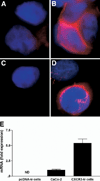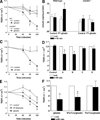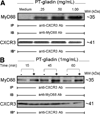Gliadin induces an increase in intestinal permeability and zonulin release by binding to the chemokine receptor CXCR3
- PMID: 18485912
- PMCID: PMC2653457
- DOI: 10.1053/j.gastro.2008.03.023
Gliadin induces an increase in intestinal permeability and zonulin release by binding to the chemokine receptor CXCR3
Abstract
Background & aims: Celiac disease is an immune-mediated enteropathy triggered by gliadin, a component of the grain protein gluten. Gliadin induces an MyD88-dependent zonulin release that leads to increased intestinal permeability, a postulated early element in the pathogenesis of celiac disease. We aimed to establish the molecular basis of gliadin interaction with intestinal mucosa leading to intestinal barrier impairment.
Methods: Alpha-gliadin affinity column was loaded with intestinal mucosal membrane lysates to identify the putative gliadin-binding moiety. In vitro experiments with chemokine receptor CXCR3 transfectants were performed to confirm binding of gliadin and/or 26 overlapping 20mer alpha-gliadin synthetic peptides to the receptor. CXCR3 protein and gene expression were studied in intestinal epithelial cell lines and human biopsy specimens. Gliadin-CXCR3 interaction was further analyzed by immunofluorescence microscopy, laser capture microscopy, real-time reverse-transcription polymerase chain reaction, and immunoprecipitation/Western blot analysis. Ex vivo experiments were performed using C57BL/6 wild-type and CXCR3(-/-) mouse small intestines to measure intestinal permeability and zonulin release.
Results: Affinity column and colocalization experiments showed that gliadin binds to CXCR3 and that at least 2 alpha-gliadin 20mer synthetic peptides are involved in this binding. CXCR3 is expressed in mouse and human intestinal epithelia and lamina propria. Mucosal CXCR3 expression was elevated in active celiac disease but returned to baseline levels following implementation of a gluten-free diet. Gliadin induced physical association between CXCR3 and MyD88 in enterocytes. Gliadin increased zonulin release and intestinal permeability in wild-type but not CXCR3(-/-) mouse small intestine.
Conclusions: Gliadin binds to CXCR3 and leads to MyD88-dependent zonulin release and increased intestinal permeability.
Conflict of interest statement
Conflicts of interest: S.N.V. and A.F. have financial relationship with Alba Therapeutics.
Figures







Similar articles
-
Gliadin, zonulin and gut permeability: Effects on celiac and non-celiac intestinal mucosa and intestinal cell lines.Scand J Gastroenterol. 2006 Apr;41(4):408-19. doi: 10.1080/00365520500235334. Scand J Gastroenterol. 2006. PMID: 16635908
-
Gliadin stimulation of murine macrophage inflammatory gene expression and intestinal permeability are MyD88-dependent: role of the innate immune response in Celiac disease.J Immunol. 2006 Feb 15;176(4):2512-21. doi: 10.4049/jimmunol.176.4.2512. J Immunol. 2006. PMID: 16456012
-
Protective Effect of 1,25-Dihydroxy Vitamin D3 on Pepsin-Trypsin-Resistant Gliadin-Induced Tight Junction Injuries.Dig Dis Sci. 2018 Jan;63(1):92-104. doi: 10.1007/s10620-017-4738-0. Epub 2017 Sep 4. Dig Dis Sci. 2018. PMID: 28871457
-
Breaking Down Barriers: How Understanding Celiac Disease Pathogenesis Informed the Development of Novel Treatments.Dig Dis Sci. 2019 Jul;64(7):1748-1758. doi: 10.1007/s10620-019-05646-y. Dig Dis Sci. 2019. PMID: 31076989 Free PMC article. Review.
-
Tight junctions, intestinal permeability, and autoimmunity: celiac disease and type 1 diabetes paradigms.Ann N Y Acad Sci. 2009 May;1165:195-205. doi: 10.1111/j.1749-6632.2009.04037.x. Ann N Y Acad Sci. 2009. PMID: 19538307 Free PMC article. Review.
Cited by
-
Celiac disease and autoimmunity: review and controversies.Curr Allergy Asthma Rep. 2013 Aug;13(4):347-53. doi: 10.1007/s11882-013-0352-1. Curr Allergy Asthma Rep. 2013. PMID: 23681421 Free PMC article. Review.
-
Skin- and gut-homing molecules on human circulating γδ T cells and their dysregulation in inflammatory bowel disease.Clin Exp Immunol. 2012 Nov;170(2):122-30. doi: 10.1111/j.1365-2249.2012.04649.x. Clin Exp Immunol. 2012. PMID: 23039882 Free PMC article.
-
Association of HLA-DQ gene with bowel transit, barrier function, and inflammation in irritable bowel syndrome with diarrhea.Am J Physiol Gastrointest Liver Physiol. 2012 Dec 1;303(11):G1262-9. doi: 10.1152/ajpgi.00294.2012. Epub 2012 Oct 4. Am J Physiol Gastrointest Liver Physiol. 2012. PMID: 23042942 Free PMC article.
-
Celiac disease: a comprehensive current review.BMC Med. 2019 Jul 23;17(1):142. doi: 10.1186/s12916-019-1380-z. BMC Med. 2019. PMID: 31331324 Free PMC article. Review.
-
Impact of Biometric Patient Data, Probiotic Supplementation, and Selected Gut Microorganisms on Calprotectin, Zonulin, and sIgA Concentrations in the Stool of Adults Aged 18-74 Years.Biomolecules. 2022 Nov 29;12(12):1781. doi: 10.3390/biom12121781. Biomolecules. 2022. PMID: 36551209 Free PMC article.
References
-
- Dewar D, Pereira SP, Ciclitira PJ. The pathogenesis of coeliac disease. Int J Biochem Cell Biol. 2004;36:17–24. - PubMed
-
- Dieterich W, Ehnis T, Bauer M, et al. Identification of tissue transglutaminase as the autoantigen of celiac disease. Nat Med. 1997;3:797–801. - PubMed
-
- Monsuur AJ, Wijmenga C. Understanding the molecular basis of celiac disease: what genetic studies reveal. Ann Med. 2006;38:578–591. - PubMed
-
- Schneeberger EE, Lynch RD. The tight junction: a multifunctional complex. Am J Physiol Cell Physiol. 2004;286:C1213–C1228. - PubMed
-
- Schuppan D. Current concepts of celiac disease pathogenesis. Gastroenterology. 2000;119:234–242. - PubMed
Publication types
MeSH terms
Substances
Grants and funding
LinkOut - more resources
Full Text Sources
Other Literature Sources
Medical

